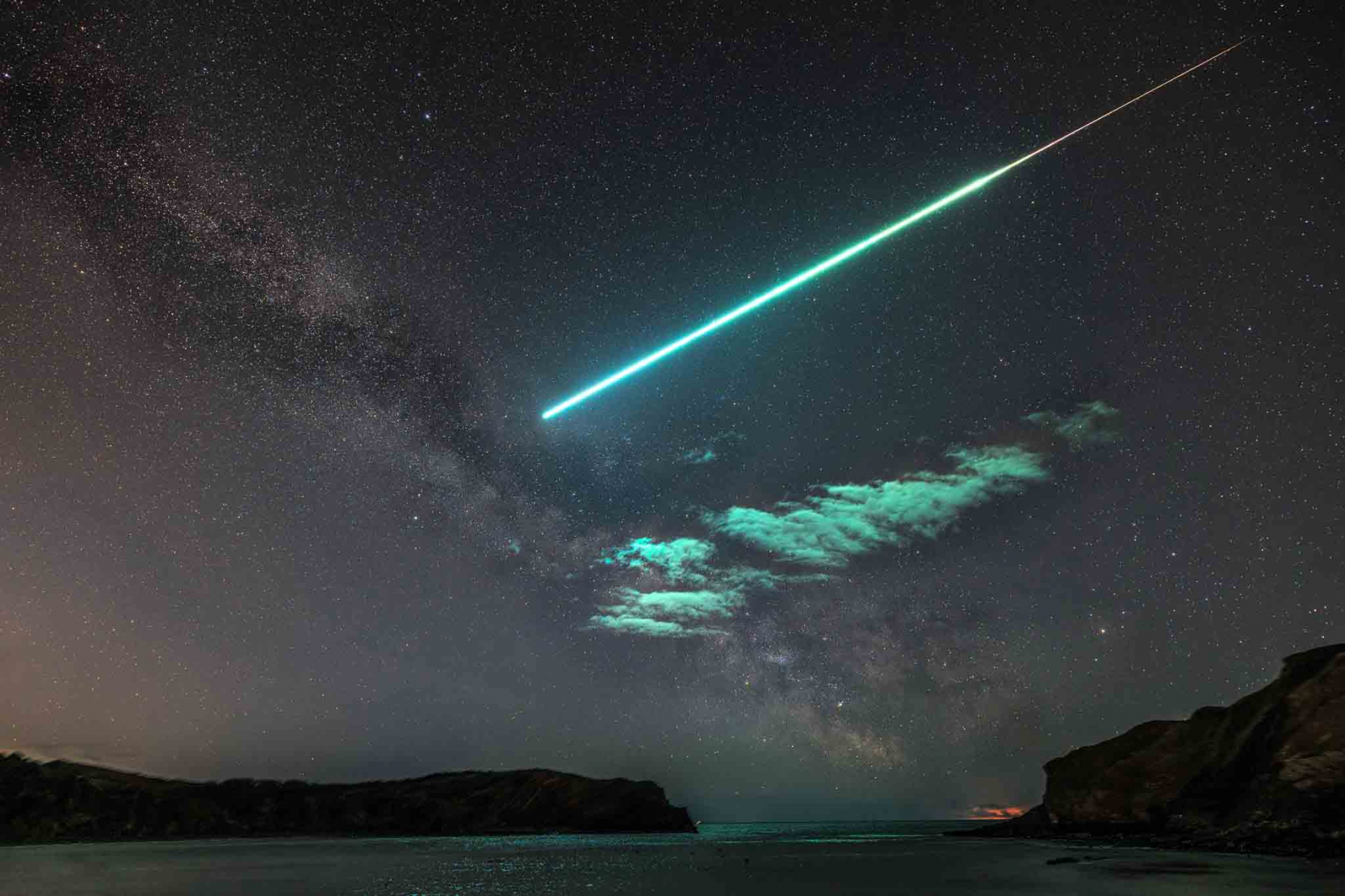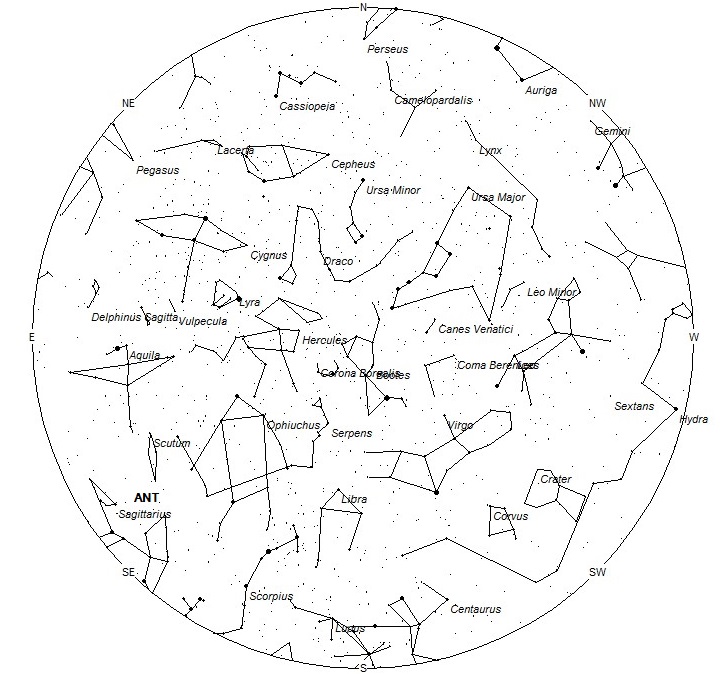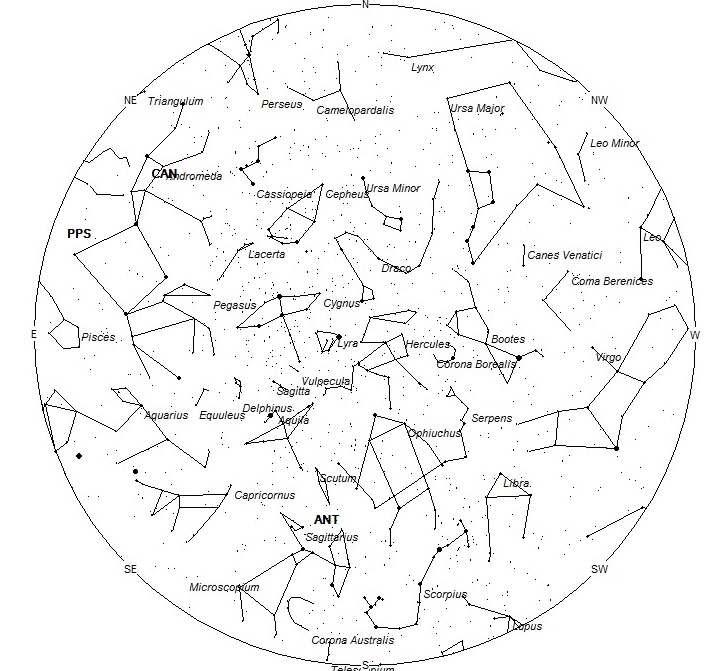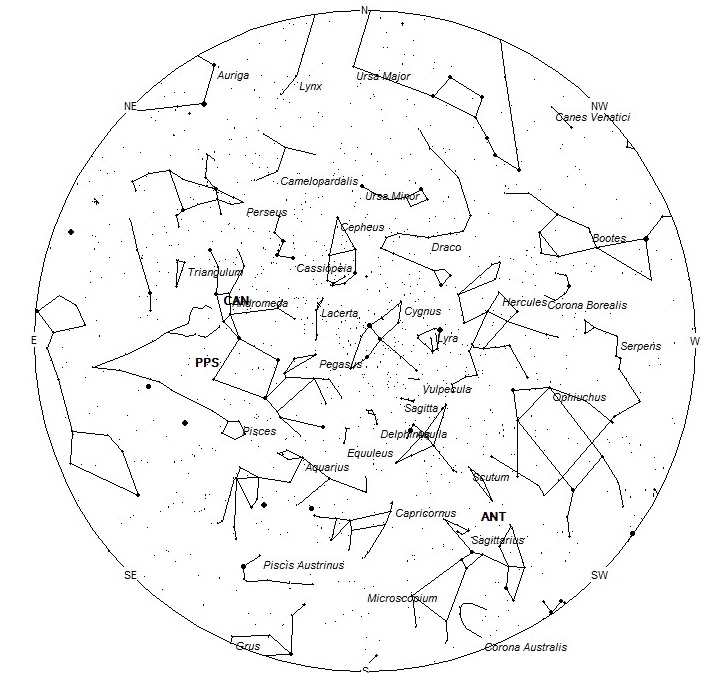 Alison Fairley captured the same fireball featured in last week’s outlook. She was just a little ways down the coast Lulworth Cove, England, on April 9 , 2022, at 3:41 BST (2:41 UT). Notice than the same cloud caught in last week’s photo is now more prominent in this shot. For more information, photos, and videos on this fireball, visit the event page. ©Alison Fairley
Alison Fairley captured the same fireball featured in last week’s outlook. She was just a little ways down the coast Lulworth Cove, England, on April 9 , 2022, at 3:41 BST (2:41 UT). Notice than the same cloud caught in last week’s photo is now more prominent in this shot. For more information, photos, and videos on this fireball, visit the event page. ©Alison FairleyDuring this period, the moon reaches its last quarter phase on Monday June 20th. At that time the moon is located 90 degrees west of the sun and will rise 01:00 and 02:00 local daylight saving time (on the 21st). This weekend the waning gibbous moon will rise during the early evening hours and will spoil the morning sky as its glare will obscure all but the brighter meteors. The estimated total hourly rates for evening observers this week should be near 2 as seen from mid-northern latitudes (45N) and 3 as seen from tropical southern locations (25S) For morning observers, the estimated total hourly rates should be near 6 as seen from mid-northern latitudes (45N) and 9 as seen from tropical southern locations (25S). Morning rates are reduced due to moonlight. The actual rates will also depend on factors such as personal light and motion perception, local weather conditions, alertness, and experience in watching meteor activity. Note that the hourly rates listed below are estimates as viewed from dark sky sites away from urban light sources. Observers viewing from urban areas will see less activity as only the brighter meteors will be visible from such locations.
The radiant (the area of the sky where meteors appear to shoot from) positions and rates listed below are exact for Saturday night/Sunday morning June 18/19. These positions do not change greatly day to day so the listed coordinates may be used during this entire period. Most star atlases (available at science stores and planetariums) will provide maps with grid lines of the celestial coordinates so that you may find out exactly where these positions are located in the sky. I have also included charts of the sky that display the radiant positions for evening, midnight, and morning. The center of each chart is the sky directly overhead at the appropriate hour. These charts are oriented for facing south but can be used for any direction by rotating the charts to the desired direction. A planisphere or computer planetarium program is also useful in showing the sky at any time of night on any date of the year. Activity from each radiant is best seen when it is positioned highest in the sky, either due north or south along the meridian, depending on your latitude. It must be remembered that meteor activity is rarely seen at the radiant position. Rather they shoot outwards from the radiant, so it is best to center your field of view so that the radiant lies at the edge and not the center. Viewing there will allow you to easily trace the path of each meteor back to the radiant (if it is a shower member) or in another direction if it is sporadic. Meteor activity is not seen from radiants that are located far below the horizon. The positions below are listed in a west to east manner in order of right ascension (celestial longitude). The positions listed first are located further west therefore are accessible earlier in the night while those listed further down the list rise later in the night.
These sources of meteoric activity are expected to be active this week.
.
The large Anthelion (ANT) is currently centered at 18:40 (280) -23. This position lies in northern Sagittarius, 3 degrees northeast of the 3rd magnitude star known as Kaus Borealis (lambda Sagittarii). This radiant is best placed near 01:00 Local Daylight Saving Time (LDST) when it lies on the meridian and is highest in the sky. Rates at this time should be near 1 per hour as seen from the Northern Hemisphere and 2 as seen from south of the equator. With an entry velocity of 30 km/sec., the average Anthelion meteor would be of slow velocity.
The phi Piscids (PPS) have been found to be comprised of two components with separate activity periods. Component A is active from June 13 through July 5 with maximum activity occurring on June 25th. Current rates are less than 1 meteor per hour. The position of the radiant lies near 00:22 (006) +18. This position lies in northwestern Pisces, 3 degrees northeast of the 3rd magnitude star known as Algenib (gamma Pegasi). This area of the sky lies highest in a dark sky during the last hour prior to dawn. With a entry velocity of 66km/sec., these meteors are swift.
The c-Andromedids (CAN) were discovered by Sirko Molau and Juergen Rendtel using video data from the IMO network. Activity from this source is seen from June 21 through July 28 with maximum activity occurring on July 12. The radiant currently lies at 00:35 (009) +40, which places it in northern Andromeda, 3 degrees southwest of the Great Andromeda Galaxy, which is visible to the naked eye as a small cloud. This area of the sky is best seen during the last dark hour before dawn when the radiant lies highest in a dark sky. Observers in the northern hemisphere are better situated to view this activity as the radiant rises much higher in the sky before dawn compared to southern latitudes. Current rates would be less than 1 per hour no matter your location. With an entry velocity of 56 km/sec., the average meteor from this source would be of swift velocity.
As seen from the mid-northern hemisphere (45N) one would expect to see approximately 5 sporadic meteors per hour during the last hour before dawn as seen from rural observing sites. Evening rates would be near 1 per hour. As seen from the tropical southern latitudes (25S), morning rates would be near 7 per hour as seen from rural observing sites and 2 per hour during the evening hours. Locations between these two extremes would see activity between the listed figures. Morning rates are reduced due to moonlight.
You can keep track of the activity of these meteor showers as well as those beyond the limits of visual observing by visiting the NASA Meteor Shower Portal available at: https://meteorshowers.seti.org/ You can move the sky globe to see different areas of the sky. Colored dots indicate shower meteors while white dots indicate sporadic (random) activity. The large orange disk indicates the position of the sun so little activity will be seen in that area of the sky.
The list below offers the information from above in tabular form. Rates and positions are exact for Saturday night/Sunday morning except where noted in the shower descriptions.
| SHOWER | DATE OF MAXIMUM ACTIVITY | CELESTIAL POSITION | ENTRY VELOCITY | CULMINATION | HOURLY RATE | CLASS |
| RA (RA in Deg.) DEC | Km/Sec | Local Daylight Saving Time | North-South | |||
| Anthelions (ANT) | – | 18:40 (280) -23 | 30 | 02:00 | 1 – 2 | II |
| phi Piscids (PPS) A | Jun 25 | 00:22 (006) +18 | 66 | 08:00 | <1 – <1 | IV |
| c-Andromedids (CAN) | Jul 12 | 00:35 (009) +40 | 56 | 08:00 | <1 – <1 | IV |
 American Meteor Society
American Meteor Society



I believe I saw one around 11:20 pm tonight Sunday night in sky it was very fast and went by car as if going down appeared bluish and very bright. Inm in louisiana could it of been one???
Omg I seen it too,around the same time by oh are airport ! It was huuuuuuge!!!!! Looked like it was coming down to earth kinda got scared tbh. But wow !!!! It was like white with orange and blue, crazy !
Thanks. Learned a lot. Hope the Journey is treating you well. Peace
Saw one tonight over Woodstock Ga. Quite a sight!
I am in galva Illinois, at 5:21am chicago time looking NE, i seen one for few seconds then it disappeared.
cool.
I saw a blue flashing light falling from the sky 6.15 pm today in Rio Claro Trinidad about 200 feet from me